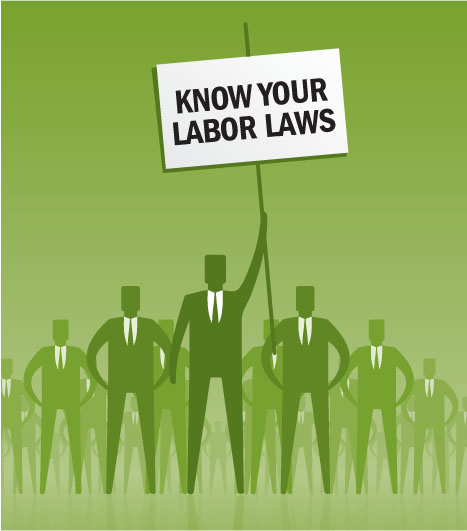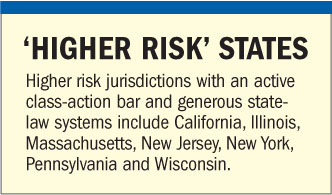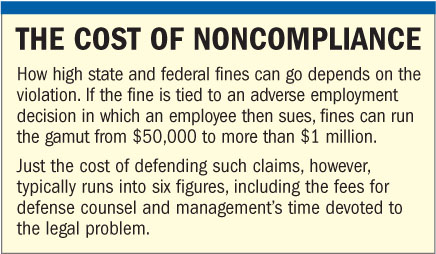 Employers inhabit a complexenvironment when it comes to human-resources statutes. Federal,state and local laws and regulations are in a constant state ofevolution.
Employers inhabit a complexenvironment when it comes to human-resources statutes. Federal,state and local laws and regulations are in a constant state ofevolution.
Complying with this patchwork quilt of workplace obligations isa daunting challenge for an organization's risk-management andhuman-resources professionals, corporate counsel andexecutives.
|But like death and taxes, these risks of doing business areinevitable—and the costs of noncompliance are increasing.
|With the turn of the calendar, and in keeping with the traditionof New Year's resolutions, here is a list of 10 "to-do" items thatought to be on any HR/risk-manager's compliance checklist for2012.
|1. Keep track of government enforcementefforts.
|The two main enforcement arms of the federal government relevantto private employers are the Equal Employment OpportunityCommission (EEOC) and the Department of Labor (DOL). On the statelevel, virtually every state has similar agencies. Knowing howthese agencies enforce the law under their mandates is crucial forcorporate-compliance efforts.
|The EEOC and DOL have extensive Web sites (www.eeoc.gov andwww.dol.gov) that detail their activities. HR professionals, riskmanagers, corporate counsel and business executives in charge ofcompliance efforts should bookmark these sites and visit themfrequently. They contain a treasure trove of information foremployers.
|2. Audit your personnel policies for compliance with newEEOC-related regulations.
|Especially on a state and local basis, laws creating protectionsfor employees typically have a Jan. 1 effective date. It's alwaysbest to check the legislative enactments for every jurisdiction inwhich the company employs workers.
|Relevant EEOC policies and practices should be updated for thesenew obligations.
|3. Account for leave-of-absence entitlements created bynew laws at the state and local level.
|Likewise, state and local governments have become aggressive inexpanding the rights for mandatory leave-of-absence entitlementsfor workers. The coverage trip wires tend to vary by jurisdiction,such as companies with 50 or more full-time employees vs. oneemployee.
|Like EEOC laws, many leave-of-absence entitlements kick in atdifferent dates during the calendar year.
|Since violations of leave entitlements typically involve"gotcha" situations if leave is denied, compliance strategiesrequire a comprehensive approach to integrate any new leaveentitlements into the company's existing portfolio of benefits.
|4. Check your reasonable-accommodationprocedures.
|An area of key focus for the EEOC is protecting the rights ofsick, injured and disabled employees who need reasonableaccommodations. Recent amendments to the Americans withDisabilities Act (ADA) (see article on page 28) also makelitigation over personnel decisions on reasonable accommodationstougher to defend.
|Having a state-of-the-art standard operating procedure toapproach requests for reasonable accommodations is a necessaryrisk-management tool. If your corporate policies and procedureshave not been updated in the last few years, this should be an areaof focus in 2012.
|5. Audit your payroll policies andprocedures for compliance with new laws and case-lawdevelopments.
|Wage-and-hour litigation continues to be the No. 1 source ofemployment-related lawsuits. Case-law precedents are evolving at arapid pace as the federal Fair Labor Standards Act of 1938 (FLSA)is interpreted to situations arising in the new digital workplaceof modern corporate America.
| The volume of such litigation hasincreased every year over the past decade. Further, employersoperating in "higher risk" jurisdictions with an activeclass-action bar and generous state-law systems—such as California,Illinois, Massachusetts, New Jersey, New York, Pennsylvania andWisconsin—are particularly vulnerable.
The volume of such litigation hasincreased every year over the past decade. Further, employersoperating in "higher risk" jurisdictions with an activeclass-action bar and generous state-law systems—such as California,Illinois, Massachusetts, New Jersey, New York, Pennsylvania andWisconsin—are particularly vulnerable.
A payroll policies-and-practice audit makes good sense,especially if it is conducted under the auspices of theattorney/client privilege, since this may provide the company witha "good faith" defense under FLSA.
|6. If you utilize workplace arbitration agreements, testthe agreement terms under new case law.
|The Supreme Court's ruling in April of 2011 in AT&TMobility LLC v. Concepcion (which, going forward, will make itmuch harder for consumers to file class-action lawsuits) raises theissue of whether that decision tips the scales in favor ofemployers implementing an arbitration policy covering workplaceclaims by employees.
|Each employer must weigh the advantages and disadvantagesdifferently in light of its workforce, culture, policies andstrategic goals. The Concepcion decision, however,particularly for large employers facing significant employmentlitigation challenges, may well tip the balance in favor ofimplementing a nationwide arbitration program that minimizes thethreat of class or collective actions. If you have not alreadyengaged in a balancing of those factors for your company, this is akey item for your compliance checklist.
|7. Account for the impact of social media in yourworkplace.
|Employers operate in an environment where social media canaffect customers, shareholders and employees. In anticipation ofthe issues posed by employees' use of social media, it makes goodsense to implement personnel policies that arm the company withdiscretion to protect its rights and discipline employees ifnecessary for social-media abuse.
|Policies on blogging and use of social media by employees are agreat place to start (see article on page 33).
|8. Treat EEOC charges with respect—and with a thoroughdefense.
|The EEOC's recent fiscal year 2011 report details its activitiesfrom Oct. 1, 2010 to Sept. 30, 2011. This should be requiredreading for corporate counsel, risk managers and HR professionalswho deal with employment-related litigation issues.
|The report details an inevitable byproduct ofour nation's economic woes. In fiscal year 2011, the EEOC receiveda record-high 99,947 discrimination charges against private-sectoremployers.
| This statistic confirms whatemployers are experiencing—terminations and adverse-employmentdecisions are increasingly high-risk situations. Workers who losetheir jobs often file discrimination charges not only on account ofbelieving themselves to be discrimination victims, but also out offear and self-preservation that compel them to "sue now" if theirprospects for re-employment are dim in today's economy.
This statistic confirms whatemployers are experiencing—terminations and adverse-employmentdecisions are increasingly high-risk situations. Workers who losetheir jobs often file discrimination charges not only on account ofbelieving themselves to be discrimination victims, but also out offear and self-preservation that compel them to "sue now" if theirprospects for re-employment are dim in today's economy.
It also comes as no surprise, then, that the EEOC recovered arecord $364 million for discrimination victims throughadministrative enforcement.
|Title VII claims still dominate these filings, representing 75percent of the charge filings in fiscal year 2011. ADA claims andretaliation, however, are also strongly represented, accounting fora significant number of the overall settlements in the pastyear.
|Finally, the EEOC's systemic-discrimination program continues toexpand. The commission is aggressively investigating employers whoare party to discrimination charges on the theory that "where thereis smoke, there is apt to be fire," in that discrimination rarelyimpacts one protected category worker but most often groups ofemployees.
|In this enforcement environment, an employer is well-served totreat an EEOC charge as a serious litigation event. A thoroughinvestigation, careful pleadings and aggressive defense handlingwill pay dividends in these circumstances.
|9. Redouble your efforts to prevent retaliation in theworkplace.
|Retaliation is on the rise statistically, according to theEEOC's latest fiscal-year report. Retaliation often involves asituation where a defensible discrimination charge is turned intoan indefensible retaliation charge, because company managers actedimproperly after the company's receipt of the initialdiscrimination charge.
|The risk of retaliation can be managed and its incidenceminimized by a standard operational procedure designed tocommunicate the company's policy against retaliation and itscommitment to disciplining—and terminating when appropriate—anyemployee who compromises the company's policy.
|If your business' approach to prevent retaliation could standupdating, this is certainly a focus area worthy of yourchecklist.
|10. Deliver on the notion of workplace dueprocess.
|One indication of the robust administration of HR policies andprocedures is a high ratio of internal complaints as compared to alow number of external complaints to the EEOC or similargovernmental agencies. The notion of "workplace due process" is atthe heart of this balance.
|In other words, do employees believe that the company's HRsystem investigates their complaints and grievances—and remediatesthe situation where appropriate—so that they receive "dueprocess"?
|If employees feel that their voices are not heard or respected,it should come as no surprise that they are more likely to contactoutside agencies or plaintiffs' lawyers to champion theircomplaints.
|Injecting and instilling the notion of workplace due processinto the administration of your company's HR policies and practicescan be one of the most important EPLI risk-management devices toimplement in 2012.
Want to continue reading?
Become a Free PropertyCasualty360 Digital Reader
Your access to unlimited PropertyCasualty360 content isn’t changing.
Once you are an ALM digital member, you’ll receive:
- All PropertyCasualty360.com news coverage, best practices, and in-depth analysis.
- Educational webcasts, resources from industry leaders, and informative newsletters.
- Other award-winning websites including BenefitsPRO.com and ThinkAdvisor.com.
Already have an account? Sign In
© 2024 ALM Global, LLC, All Rights Reserved. Request academic re-use from www.copyright.com. All other uses, submit a request to [email protected]. For more information visit Asset & Logo Licensing.








